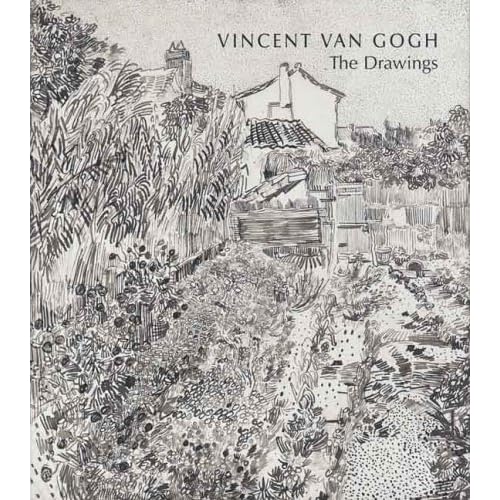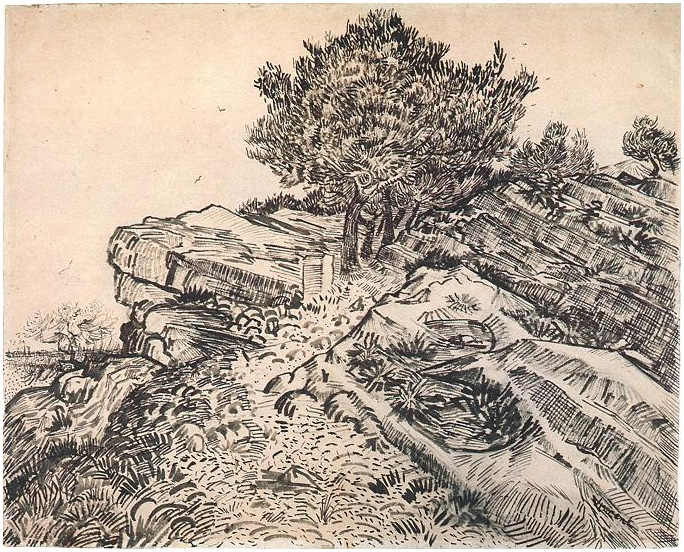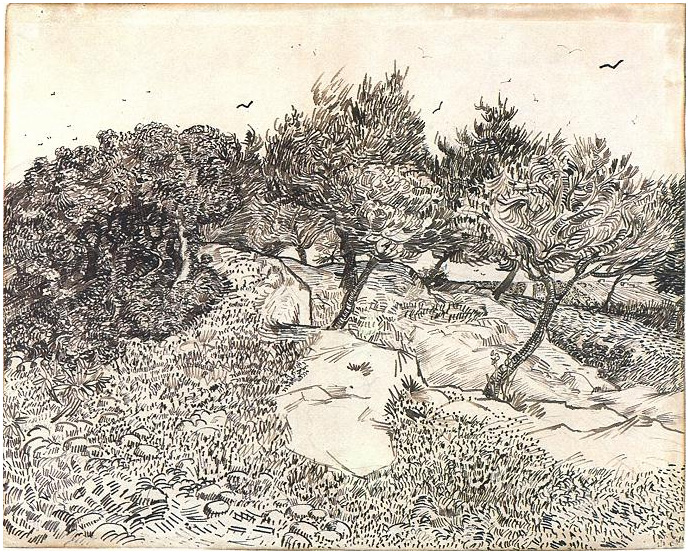The first major exhibition in the United States ever to focus on Vincent van Gogh's extraordinary drawings appearedt The Metropolitan Museum of ArtOctober 18 – December 31, 2005. Vincent van Gogh: The Drawings — comprising 113 works selected from public and private collections worldwide, including an exceptional number of loans from the Van Gogh Museum in Amsterdam — will reveal the range and brilliance of the artist's draftsmanship as it evolved over the course of his decade-long career. Generally over-shadowed by the fame and familiarity of his paintings, Van Gogh's more than 1,100 drawings remain comparatively unknown although they are among his most ingenious and striking creations. Van Gogh engaged drawing and painting in a rich dialogue, which enabled him to fully realize the creative potential of both means of expression. A group of paintings was exhibited alongside the related drawings.

Van Gogh's pen-and-ink Self-Portraits (1887), at the Metropolitan Museum of Art.
(Photo: Van Gogh Museum, Amsterdam (Vincent Van Gogh Foundation/Courtesy of the Metropolitan Museum of Art, New York))
The exhibition was jointly organized by The Metropolitan Museum of Art, New York, and the Van Gogh Museum, Amsterdam.
Exhibition Organization and Content
Retrospective in scope, Vincent van Gogh: The Drawings traced the artist's successive triumphs as a draftsman, first in the Netherlands and later in France, highlighting the originality of his invention and the striking continuity of his vision. Among the works exhibited were an early series of large-scale views of the garden at his father's vicarage drawn by Van Gogh in March 1884. Distinctive for their melancholy grandeur and regarded as the high point of his early work as a draftsman, drawings from this ambitious suite, including two versions of the Winter Garden in contrasting horizontal and vertical formats, will be reunited in the present show.
Van Gogh produced most of his greatest drawings and watercolors during the little more than two years he spent working in Provence. Compositions created in Arles (February 1888–May 1889) form the central portion of the exhibition, bracketed by earlier and later works.
Largely self-taught, Van Gogh believed that drawing was "the root of everything." His reasons for drawing were numerous. At the outset of his career, he felt it necessary to master black and white before attempting to work in color. Thus, drawings formed an inextricable part of his development as a painter. There were periods when he wished to do nothing but draw. Sometimes, it was a question of economics: the materials he needed to create his drawings — paper and ink purchased at nearby shops and pens he himself cut with a penknife from locally grown reeds — were cheap, whereas costly paints and canvases had to be ordered and shipped from Paris. When the fierce mistral winds made it impossible for him to set up an easel, he found he could draw on sheets of paper tacked securely to board.
Van Gogh used drawing to practice interesting subjects or to capture an on-the-spot impression, to tackle a motif before venturing it on canvas, and to prepare a composition. Yet, more often than not, he reversed the process by making drawings after his paintings to give his brother and his friends an idea of his latest work. Over a three-week period, between mid-July and early August in 1888, he reproduced some 30 of his paintings in pen-and-ink drawings, which he sent to two artist friends, Émile Bernard and John Russell, and to his brother Theo.
A number of these highly stylized presentation drawings were on view. The New York venue of the exhibition uniquely featured multiple renditions of key motifs: Boats at Sea, Saintes-Maries-de-la-Mer and Arles: View from the Wheat Fields. Each of Van Gogh's paintings of these subjects was shown with three pen-and-ink répétitions. Never before seen together, these dossiers offered a fascinating glimpse of Van Gogh's successive re-interpretations — through line — of vibrant color compositions.
Several important series of drawings, including the sweeping landscapes he composed atop Montmajour, were featured. The artist regarded the Montmajour suite of six drawings, which range from elaborate panoramic vistas of the countryside to spirited views of the rocky mountain slopes with their windblown trees, as his greatest achievement as a draftsman. These landscapes were exceptionally reunited for this exhibition. In addition, a number of portraits and figure studies were on view, including a rare self-portrait, one of only two such drawings known.
Van Gogh's dialogue between drawing and painting was most fully realized while he was working in Arles and in nearby Saint-Rémy. Several paintings from this period will be exhibited alongside related drawings. In a splendid grouping, the oil
.jpg!Large.jpg)
Harvest in Provence of ca. June 12, 1888
— very seldom lent by the Van Gogh Museum — were shown with a brilliant preparatory watercolor and a dazzling pen-and-ink drawing Van Gogh made after his painting.
From a NY Times review (images added):
Montmajour
Vincent van Gogh
Drawing, Pencil, pen, reed pen, and ink on paper
Arles: July, 1888
Van Gogh Museum
Olive Trees, Montmajour
Vincent van Gogh
Drawing, Pencil, pen, reed pen, and ink on paper
Arles: July, 1888
Van Gogh Museum
Hill with the Ruins of Montmajour
Vincent van Gogh
Drawing, Pencil, pen, reed pen, and ink on paper
Arles: July, 1888
Van Gogh Museum
Made with a scratchy reed pen on large sheets of Whatman paper, his Montmajour drawings come about two-thirds of the way through the survey of van Gogh's drawings now at the Metropolitan Museum of Art. They translate sky, rocks and plains into a swarm of swirls, dots, jabs and scratches. Foaming, cable-knit patterns imply the heaving gusts of wind rustling olive branches and bending gnarled olive trunks; whispery, microscopic speckles, endless numbers of them, mimic the quality of dull light on receding fields as they evaporate into the horizon. You can even sense color - the dark brown of the earth, the yellow and lilac fields and gray-blue sky - in van Gogh's black and white.
Fascinating review (excerpt):
More interesting reviews here AND here
Vincent van Gogh, Cottage Garden 1888 reed pen, quill, and ink over graphite on wove paper, 24 x 19-1/4 inches Private Collection, Courtesy Metropolitan Museum of Art
In the drawing Cottage Garden the limited number of marks Van Gogh used to create this compelling rendering of observed facts grace it with a seductive vibratory energy. He uses a variety of circles, curved lines, straight lines, and dots to delineate a frothy mass of flora and fauna, open sky with bright sunlight coursing through it, and fences and houses. By playing sparse areas off of busy areas in a breathtakingly rhythmic way he suggests a three dimensional space. Like a number of Impressionist painters Van Gogh loved to challenge himself by trying to render large patches of organic forms that avoid specificity and were constantly reconfigured by the elements, wind especially.

The exhibition was accompanied by a fully illustrated catalogue by Ms. Ives, Ms. Stein, Mr. van Heugten, and Ms. Vellekoop. Published by The Metropolitan Museum of Art and distributed by Yale University Press, the publication will be available in hard- and softcover editions in the Museum's book shops. This catalogue represents the first fully illustrated and documented study of Van Gogh's drawings. The four curators explore the enduring questions that surround Van Gogh's works as a draftsman: their manufacture; their artistic precedents; the significance of the artist's drawings to his development as a painter; and their contribution to Modernism. The catalogue presents a wealth of information essential to present and future Van Gogh scholarship.
More images;;

Vincent van Gogh, La Crau from Montmajour, a brown ink drawing over black chalk
Arles, France, AD 1888




